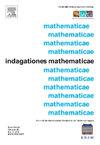Conditions for the difference set of a central Cantor set to be a Cantorval. Part II
IF 0.8
4区 数学
Q3 MATHEMATICS
引用次数: 0
Abstract
Let be the central Cantor set generated by a sequence . It is known that the difference set has one of three possible forms: a finite union of closed intervals, a Cantor set, or a Cantorval. In the previous paper (Filipczak and Nowakowski, 2023), there was given the sufficient condition for the sequence , which implies that is a Cantorval. In this paper we give different conditions for a sequence , which guarantee the same assertion. We also prove a corollary, which provides infinitely many new examples of Cantorvals.
中心康托集的差集是康托瓦尔的条件。第二部分
设C(a)∧[0,1]是由序列a=(an)∈0,1n生成的中心康托集。已知差分集C(a)−C(a)具有三种可能的形式之一:闭区间的有限并、Cantor集或Cantorval集。在之前的论文(Filipczak and Nowakowski, 2023)中,给出了序列a的充分条件,这意味着C(a)−C(a)是Cantorval。本文给出了序列a的不同条件,以保证同一断言。我们还证明了一个推论,该推论提供了无限多的Cantorvals的新例子。
本文章由计算机程序翻译,如有差异,请以英文原文为准。
求助全文
约1分钟内获得全文
求助全文
来源期刊
CiteScore
1.20
自引率
16.70%
发文量
74
审稿时长
79 days
期刊介绍:
Indagationes Mathematicae is a peer-reviewed international journal for the Mathematical Sciences of the Royal Dutch Mathematical Society. The journal aims at the publication of original mathematical research papers of high quality and of interest to a large segment of the mathematics community. The journal also welcomes the submission of review papers of high quality.

 求助内容:
求助内容: 应助结果提醒方式:
应助结果提醒方式:


